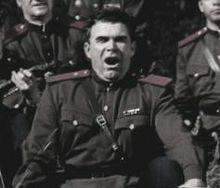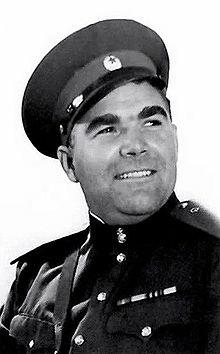Nikolaj Timofeevich Gres
28 December 1920 Kobeljaky – 25 March 2003 Simferopol


During World War II, Gres sustained an injury resulting in a brain contusion.
From 1946, Gres was a soloist of the Black Sea Fleet Ensemble.
From 1955 to 1963 (1950–1960 according to basso Leonid Kharitonov), he was a soloist of the Bolshoj Theatre, and his debut
with the Bolshoj was on 11 February 1956 in Moscow.
He then joined the Aleksandrov Ensemble until 1973 (just 1964–1965 according to Kharitonov). After leaving the ensemble, he worked
briefly in Moscow teaching automobile engineering, then moved to Simferopol in the Ukraine,
where he became an administrator in the Simferopol Philharmonic Society.
In his last years, Gres suffered poor health and died suddenly in hospital at Simferopol.
In 2001, a biography of Gres was published in the Crimea under the title My whole life with a song
(Vsju zhizn-s pesnej), by I. Turchin.
With the Aleksandrov Ensemble he recorded I was going back from Berlin (1966), The birch tree (1965),
Truth of the century (1970), The river flows (1963), Pokhodnaja/French marching song (1963), My Friends,
The grey cuckoo (1965), ObelisksObeliski/Obelisks (1966),
Pesnja pro golovu (1967),
I have travelled the whole universe (1969); as far as opera, he recorded the complete role of Sobinin in Ivan Susanin (Zhizn za
tsarja).
In RA format
Comments on Gres singing Berjozka (The birch tree)
This is a late medieval composition about a man
sitting under a birch tree, whittling and thinking of women. It is usually categorised as a folk song as the name of the composer
has been lost. However it is clearly a professional composition of a quality comparable to those of medieval Northern European
composers of troubadour songs, such as Dufay and Binchois. This performance is part of the history of the early music revival
movement. In the 19th century, rediscovered early music, along with folk music, was usually arranged to be performed in the
grand orchestral or Italian operatic style. However, such music had always survived in church music, in one form or another,
and people were used to hearing it performed in the style of traditional European church choirs: no vibrato; pure and clear tone;
adjusting the voice production to the acoustics of the building. In church music, the building was always the secondary soundbox
for the vocal instrument (the nasal cavity being the first). From the 1950s, early music performance reverted to this
ecclesiastical style of singing. So the Aleksandrov Ensemble performance of ca. 1963 was very modern for its time.
Gres sings like a church choir baritone, with the same appearance of spiritual joy as any oratorio soloist.
His voice is responding to a building-soundbox, too; in this case a recording studio. The Russian practice of the time was
to film outdoors and then dub the sound later. Studio dubbing tends to appear artificial today, but on this occasion (a video of
the performance exists, editor's note) it
is advantageous, as the church choral style does need a building-soundbox. From the 1970s, some early music singers,
such as the Martin Best Ensemble, started to reflect what may have been the contemporary late medieval performance-style of
troubadour songs: that is, the Arab singing style which can still be heard in Islamic sung prayer. Hence Gres' performance now sounds a little dated, but remains nonetheless one of
the finest recorded performances of this song.
Source
In RA format
|

